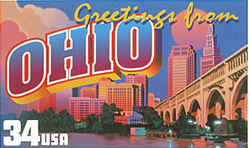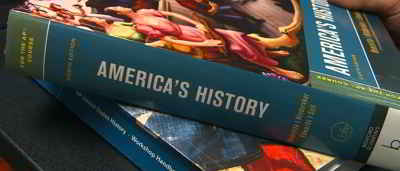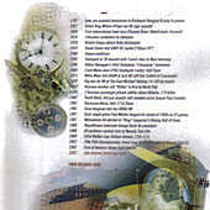

Ohio History Timeline
Important Dates, Events, and Milestones in Ohio History
Offers a chronological timeline of important dates, events, and milestones in Ohio history.Around 13,000 BCE, the early hunting and gathering people live in the area now known as Ohio in the last centuries of the Ice Age, hunting now-extinct species such as mammoth and mastodon. Coming upon 8000-500 BCE, the Archaic hunters and gatherers find new ways to harvest Ohio's bounty as the climate warms and thick forests grow across the area. And from 800 BCE - 100, the Adena people become Ohio's first farmers, growing plants such as sunflowers and squash. Many of their thousands of burial mounds have survived in Ohio- the Serpent Mound in Adams County is the largest effigy mound in the U.S.
Initially colonized by French fur traders, Ohio became a British colonial possession following the French and Indian War in 1754. At the end of the American Revolution, Britain ceded control of the territory to the newly formed United States, which incorporated it into the Northwest Territory. Ohio became a state on March 1, 1803, although no formal declaration was made until 1953, when President Dwight Eisenhower officially signed the documents making it a state, retroactive to the original date.
17th Century Ohio History Timeline
1670 - Rene-Robert Cavelier explores and claims the Ohio region for France
18th Century Ohio History Timeline
1750 - The Ohio Company of Virginia claims the Ohio region for England
1763 - French surrender's claim to Ohio to Britain
1787 - Ohio becomes part of the Northwest Territory
1795 - Treaty of Greenville ends the Indian Wars in Ohio
1788 - April 7 - Marietta was Ohio's first permanent settlement. It was founded in 1788 by General Rufus Putnam and named in honor of Marie Antoinette, then queen of France
19th Century Ohio History Timeline
1800 - The Division Act creates the Indian Territory
1802 - Congress authorizes formation of a state government in Ohio.
1803 - March 1 - Ohio admitted to the Union as the 17th state. Chillicothe is named state capital.
1804 - Ohio University, founded in 1804 in Athens, was the first university in Ohio and the Northwest Territory.
1810 - Zanesville named state capitol.
1811 - Tecumseh defeated at the Battle of Tippecanoe.
1812 - Fort Meigs constructed to protect Ohio from invasion during the War of 1812
1813 - British defeat in the Battle of Lake Erie
1816 - Columbus named state capitol.
1817 - The first abolitionist newspaper, The Philanthropist, is published in Mt. Pleasant.
1825 -
- The National Road reaches St. Clairsville.
- Construction on the Miami and Erie canals begins.
1832 - Ohio and Erie canals are completed.
1833 - The nation's first interracial, coeducational college, Oberlin College, was founded in Oberlin in 1833.
1834 - The Ohio Anti-Slavery Society is founded in Zanesville.
1835 - Boundary disputes between Michigan and Ohio cause the Toledo War
1840 - William Henry Harrison, from North Bend, elected president.
1842 - The Wyandottes, Ohio's last Indian tribe, leave Ohio
1845 -
- The State Board of Agriculture is organized.
- The Miami and Erie Canal was completed
1849 - The first Ohio State Fair opens.
1850 -
- Ohio leads all states in corn, horses, sheep and wool production.
- The second US Women's Rights Convention is held in Salem.
1851 - Current Ohio Constitution adopted.
1859 - John Brown, an abolitionist from Akron, leads raid on Harper's Ferry, VA.
1861-1865 - Civil War , Ohio fought for the Union but the state showed mixed feelings toward slavery.
1861 - Ohio Statehouse completed.
1863 - The Battle of Buffington Island becomes the only Civil War battle in Ohio.
1868 - Ulysses S. Grant, from Point Pleasant, is elected president.
1869 -
- Cincinnati Redstockings become the first fully professional baseball team.
- W. F. Semple of Mount Vernon patented chewing gum
1870 -
- Ohio State University is founded.
- Benjamin Goodrich opens a rubber plant in Akron
1873 - Ohio Agricultural and Mechanical College opens.
1876 - Rutherford B. Hayes, from Delaware, is elected president.
1878 - James Ritty of Dayton developed the first cash register.
1879 - Cleveland became the world's first city to be lighted
electrically in 1879 when Charles Brush successfully demonstrated arc lights on the streets.
1880 - James Garfield, from Orange, is elected president.
1888 - Benjamin Harrison, from North Bend, is elected president.
1892 - Cedar Point opens its first roller coaster.
1896 - In Marietta, John Gilman first used x-rays in surgery.
1898 - Henry Timken of Canton developed the roller bearing.
1891 - John Lambert of Ohio City made America's first automobile.
20th Century Ohio History Timeline
1902 - Ohio flag adopted by Ohio Legislature.
1903 - The Wright Brothers, a pair of bicycle shop owners from Dayton, became the first in flight
1903 - Ohio celebrates centennial.
1908 - William Howard Taft, from Cincinnati, is elected president.
1911 - Charles Kettering of Loudonville invented the first automobile self-starter in 1911.
1913 - Spring floods kill 428 people.
1914 - The Ohio Conservancy Act permits formation of watershed districts.
1917 - US enters World War I. About 6,800 Ohio soldiers will be killed.
1920 - Warren G. Harding, from Corsica, is elected president.
1921 - The Bing Act passes, requiring students to remain in school until graduation or age 18.
1923 - Garrett Morgan of Cleveland invented the first traffic light.
1925 - The dirigible Shenandoah crashes near Alva, killing 14 people.
1929 -
- Steel becomes Ohio's number one industry.
- Great Depression hit the nation
1934 - The first state sales tax is imposed at 3 percent.
1937 - The Ohio River floods, leaving 750,000 people homeless.
1938 - Roy J. Plunkett of New Carlisle invented Teflon.
1941 - US enters World War II; about 20,000 Ohio servicemen will be killed.
1946 - The US Air Force chooses Chuck Yeager, a pilot instructor at Wright Field, to test its first rocket aircraft, breaking the sound barrier in 1947.
1949 - The Ohio Department of Natural Resources is created by the Legislature.
1953 - Congress discovers it neglected to officially recognize Ohio's statehood and passes a formal resolution declaring Ohio's entry into the Union as March 1, 1803.
1955 - The Ohio Turnpike is completed.
1958 - "With God all Things are Possible" becomes the state motto.
1959 -
- The Ohio Civil Rights Commission is created to eliminate employment discrimination.
- St. Lawrence Seaway opened
- Terms of some state officials are increased from two to four years
1962 - John Glenn from New Concord was the first American to orbit the Earth in 1962.
1963 - Professional Football Hall of Fame opens in Canton.
1967 - Great Seal of Ohio is standardized.
1969 - July 20, Neil Armstrong of Wapakoneta became the first man to walk on the moon.
1970 - Four Kent State University students killed by National Guard gunfire during Vietnam War protests.
1971 - State income tax is adopted.
1973 - Ohio State Lottery approved by Ohio voters.
1974 - Xenia tornado kills 34 people.
1976 - Ohio's last commuter train is shut down
1977 - natural gas shortage occurred in severe weather conditions
1983 - Marysville Honda plant dedicated.
1986 - Astronaut Judith Resnick, of Akron, dies in the Challenger space shuttle explosion.
1990 - Ohioans struggle through the economic downturn of the 1980s; the 1990 Census reports a slow 0.5% population increase
1995 - Rock and Roll Hall of Fame opens in Cleveland.
1995 - The Bosnian Peace Agreement is signed at Wright-Patterson Air Force Base.
1998 - John Glenn at age 77, he became the oldest American to travel into space.
21st Century Ohio History Timeline
2001 -
- Ohio ranked in the top ten in the country for growing corn, oats, winter wheat, soybeans, sweet corn, tomatoes, cucumbers, grapes, strawberries; raising chickens, hogs and pigs; and producing maple syrup and many dairy products.
- New York terrorist attacks led to flurry of anti-terrorist activities throughout Ohio;
- steam engine explosion at fair killed four, injured 49
2002 - Former representative, James Traficant, sentenced to eight-year prison term for corruption
2003 - Electric faults in Cleveland caused power outages to 50 million
2006 - Voters passed smoking ban in public places
2009 -
- Six bodies found in home of convicted sex offender in Cleveland;
- Nazi war crimes suspect John Demjanjuk, deported to Germany from Cleveland home;
- environmental activist, Marie Mason, sentenced to 22 years in prison for arson, property damage
2010 - Three Ohio pension funds filed class action lawsuit against American International Group for fraud, resulted in $725 million fine
2011 -
- Exotic animals escaped from private zoo in Zanesville, owner committed suicide, police killed dozens of the animals
- Anthony Sowell found guilty of murder of 11 women, sentenced to death
2012 -
- Gunman killed three, wounded others at high school in Chardon
- Tornadoes killed at least three, governor declared state of emergency






